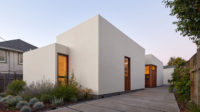A six-lane ring road encircling central Tokyo, Yamate Street is hardly a place for a private house. But when it comes to home-building in the “Big Mikan” (Japan's counterpart of the Big Apple), empty land is good land—even a tiny triangular lot wedged between a heavily trafficked boulevard and a narrow side street. The first realized work of architect Taichi Mitsuya (in collaboration with UNEMORI ARCHITECTS), the Yamate Street House occupies just such a site. Encased by bands of windows, the 54-foot-tall single-family dwelling blends inconspicuously with the high-rise office and condominium buildings nearby.
Looks can be deceiving. Devised for a 30-something leather accessories designer, the building began with a bag: after creating a tote for Mitsuya, the client sought the architect's advice and eventually hired him to design a five-story building to house his residence and studio. “Four floors made sense to us, but the client wanted to separate his atelier and living space,” says Mitsuya. To satisfy his client's request and the site's shape, the architect stacked the rooms. Progressing from common to private, each occupies one of the building's 194-square-foot levels. Linked by lightweight steel stairs, the sequence starts with a garage at grade, followed by the atelier above it, then the kitchen/dining floor, bath and living areas (divided by a curtain), the bedroom, and a roof terrace.
Though the building footprint maximizes the permissible coverage of the 258-square-foot site (surplus from the widening of Yamate Street in 2011), the legal 98-foot height limit was more than the house needed. This allowance gave Mitsuya the freedom to manipulate the building section. By differentiating floor-to-ceiling heights, he imparted to every level a distinctive character. As the building rises, the ceilings become progressively lower and the rooms more intimate. Entered through a giant door, the 12-foot-high garage could be converted to retail use at a scale in keeping with the street. At the other extreme, a 7-foot-high ceiling makes the bedroom a cozy retreat.
Correlating with the height reductions, the number of steps needed between floors decreases. Shorter stairways not only saved precious inches, they enabled the architects to change the disposition of space on each level. By locating the longest run along the north wall, the design team was able to orient the ground floor toward Yamate Street, while placing the shortest run against the west wall left plenty of room for a double bed on the top floor.
As the stairs climb, the relationship between inside and out also evolves. The sound of accelerating automobiles gradually fades, and privacy increases, as one progresses up and away from the street. At the same time, daylight and views improve, culminating at the terrace, where the city view fans out in every direction.
These transitions from the ground level to the roof are largely a function of the double rows of windows wrapping each floor—the reason the house appears to hold more than five stories. “I didn't want the building to stand out,” explains Mitsuya. On each floor, two windows are operable for natural ventilation while the rest hold single panes of fixed glass. The openings differ in size, becoming shorter and wider toward the roof. Thanks to the broadening of the windows, the views of sky and daylight coming in steadily increase, making the small spaces seem bigger.
Stepping out incrementally at each level, the shifting proportion of the windows relates inversely to the house's reinforced-concrete frame. Toward the top of the building, its load lightens, the solid walls decreasing and the voids increasing, with the narrowest openings being at the base and the widest ones at the apex. In clean, diagrammatic terms, the elevations document the building's weight-bearing strategy. But this is just about the only straightforward aspect of the structural system.
Due to the floor plan's irregular geometry and the stairs' changing orientation (which shifts the center of gravity at each level), the engineer faced complex calculations. The site's dimensions also made aspects of construction difficult. Because of poor soil conditions, the building required twelve 59-foot-deep piles. Only one company in all of Tokyo had the mini-machinery needed for the confines of the exceptionally small site. And, even for them, this was the tightest job they had ever undertaken, according to Mitsuya.
Size was also a driving force behind the minimal interior finishes and built-in furnishings. The design team applied insulating paint to the walls for climate control, but left the concrete ceilings exposed, embedded with downlights. For flooring, Mitsuya chose concrete at grade and maple almost everywhere else. He used water-resistant ipe for the bath/living level—a curious arrangement intended to separate moisture from mold-vulnerable bedding. While Mitsuya did not skimp on bath fixtures, the kitchen is spare, containing only a counter with a cooktop, sink, and small refrigerator. For storage, the architect left the client to his own devices.
When construction finished, the neighborhood kids were shocked to learn that the tall building is actually a home, but the adults barely batted an eye. “They are used to weird houses,” explains Mitsuya. In Tokyo, when it comes to designing a place to live, the sky is truly the limit.
Size: 964 square feet
Project Cost: Withheld
Completion Date: April 2014
PeopleOwner: Architect: Engineer(s): Photographer(s): |
ProductsStructural system Roofing Windows Window close: Glazing Doors Hardware Locksets: Closers: Other special hardware: Kitchen gas stove Toilet BC-110PTU+DT-C182U (@4F) Interior finishes Resilient flooring: Lighting |





















